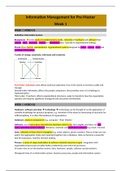Information Management for Pre-Master
Week 1
WEEK 1 VIDEO 01
Definition Information System
Bourgeouis: ‘’IS is the study of complementary works, networks of hardware and software that
collects, filters, processes, creates and distributes data. Typically in organizational settings.
Piccoli: IS are formal, sociotechnical, organizational systems designed to collect, process, store and
distribute information.
3 order of change: automate, informate and transform.
First Order: Automate; only affects technical subsystem, thus is the easiest to envision, justify and
manage.
Second order: Informate; affects the people component, thus provides more of a challenge to
implementation
Third order: Transform; affects organizational structures, seeks to transform how the organization
operates and requires significant managerial and executives involvement.
WEEK 1 VIDEO 02
Hardware, software and data Technology Technology can be thought of as the application of
scientific knowledge for practical purposes, e.g. invention of the wheel to harnessing of electricity for
artificial lighting. It is often the backbone of organizations.
Hardware: physical components (e.g. computer / iPad/ Mobile)
Software: set of instructions that tells the hardware what to do. Not tangible and there are two
types: operating-system software (Windows, Android) and application software (e.g. Excel, Chrome)
Data: Collection of facts that is intangible (e.g. street address, phone number). Pieces of data are not
useful, but aggregated, index and organized together into a database, data can become a powerful
tool for businesses. Used for decision making.
Process: a series of steps undertaken to achieve a desired outcome or goal. Integration with
organizational processes provides better productivity and control of processes.
IS-center view of an information system: data, hardware, people, software and procedures.
Managerial view of an information system: business processes, people and information system.
,LAP: Language/Action Perspective:
Focuses on what people do when communicating.
Does not start with technology, but with people communicating (In order to coordinate).
Information System of an organization can be defined as the structure by means of which
people communicate.
Communication is not primarily transfer of data, but developing a relationship.
The IM Cube
Information is linking pin between organization and the IT.
IS roles:
Information Management is typically the bridge between business and IT (like the IM cube says).
Digital transformation
Use of new digital technologies, such as social media, mobile, analytics or embedded devices, in
order to enable major business improvements like enhancing customer experience, streamlining
operations or creating new business models.
Digital transformation = use of new digital technologies, such as social media, mobile, analytics or
embedded devices, in order to enable major business improvements like enhancing customer
experience, streamlining operations or creating new business models.
Digitalization ≠ digitization
Digital transformation blurs the distinction between IT strategy and Business Strategy.
IS Manager task: Demand-side vs supply-side tasks.
Typology: Spokesman, monitor (informational) / Entrepreneur: resource allocator (decisional) /
Leader, liaison -> (bonding) (interpersonal)
, Week 2
WEEK 2 VIDEO 01
Moore’s law:
Cost of storage: The explosion of the net: The InternetOfThing
Pervasiveness:
Why is Moore’s Law important for IM?
Causes:
o Self-fulfilling prophecy (became a goal for the industry, doubling every two years,
also became the demand by the market)
o Network effects (usefulness of networks increased since more people starting using
it because of the growth)
Effects:
o Autonomous technological growth (doubling every two years)
o Unpredictability of the effects (chessboard metaphor)
, WEEK 2 VIDEO 02
Hardware and Operating System
Hardware consist of:
CPU: central processing unit: the key component of a computer
system, which contains the circuitry necessary to interpret and
execute program instructions.
Motherboard The main circuit board on the computer which
connects all other components. It provides much of the bus (bus
refers to electrical connection between different computer
components) which is an importer determiner of the computer’s
speed > the combination of how fast the bus can transfer data and
the number of data bits that can be moved a one time. (mHz)
Main memory (internal memory)
Disk (external memory)
CPU, motherboard, RAM and Hard Disk influence the speed of the
computer.
Operating system:
Device handler: each of the devices within the hardware need to be managed.
Abstraction layer: In computing, an abstraction layer or abstraction level is a way of hiding
the working details of a subsystem, allowing the separation of concerns to facilitate
interoperability and platform independence.
Two consequences of the powerful evolution of computing devices:
Commoditization PC/Mobile has become a commodity / part of our everyday live. Margins for
manufacturers are razor-thin, except for Apple. Apple does not use the open standards and makes
products which are considered to be superior and not easily copied.
Electronic Waste mostly old devices are donated to any country which will accept them. And now
it becomes a health hazard. Manufacturers try to recycle as much as possible.
Article Tilson Lyytinen et al (2010) Digital Infrastructures: The missing IS Research Agenda.
Digital infrastructure and the generativity property of digital systems
The paradoxes of change and control: what makes the infrastructure stable?
Binary system:
Basics of data representation and manipulation is binary data ( 0 and 1)
Binary system: calculating with numbers with only two digits:
o 0, 1, 10, 11, 100, 101
o Adding two binary numbers 11+10 = 101
Digital representation of characters (ASCII)
Error-detection
Hexadecimal system: ------------------------------------------------------




